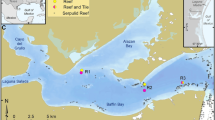Abstract
Pectinaria gouldii (Verrill), which lives for 1 year in Barnegat Bay, New Jersey, constructs over its lifetime a conical tube of increasingly large sand grains, regardless of surrounding sediment characteristics. However, the rate of increase of mean grain size of the tube and the population density of the worm vary with sediment type. The distribution of this species is limited by sediment composition. Worms of equal length will always have equal anterior tube apertures, although the thickness of the tube walls may be unequal. Tube surface-area, worm dry weight, and tube weight all increase as a power function of tube length. The conical shape and increasing mass of the tube impose an upper limit to worm growth, but do not interfere with worm mobility.
Similar content being viewed by others
Literature Cited
Bauer, E.E.: Grain-size analysis of soils. In: Procedures for testing soils, pp 88–93. Ed. by E.E. Bauer. Philadelphia: Amercian Society for Testing Materials 1958
Gordon, D.: The effects of the deposit feeding polychaete Pectinaria gouldii on the intertidal sediments of Barnstable Harbor. Limnol. Oceanogr. 11, 327–332 (1966)
Halliday, R.G.: Reproduction and feeding of Argentina sphyraena (Isopondyli) in the Clyde Sea area. J. mar. biol. Ass. U.K. 49, 785–803 (1969)
Hanks, J.E.: A method for preparing the marine polychaete, Pectinaria gouldii (Verrill), for histological study. Trans. Am. microsc. Soc. 79, 470–471 (1960)
Long, C.: Pectinariidae (Polychaeta) from Caribbean and associated waters. Bull. mar. Sci. 23, 857–874 (1973)
Loveland, R.E., K. Mountford, P. Sandine, D. Busch, E. Cohen, N. Kirk, M. Moskowitz and C. Messing: The qualitative and quantitative analysis of the benthic flora and fauna of Barnegat Bay before and after the onset of thermal addition, Prog. Rep. Rutgers Univ. (New Brunswick, N.J.) 7, 10–49 (1971)
Nichols, F.H.: Sediment turnover by a depositfeeding polychaete. Limnol. Oceanogr. 19, 945–950 (1974)
Peer, D.L.: Relation between biomass, productivity, and loss to predators in a population of a marine benthic polychaete, Pectinaria hyperborea. J. Fish. Res. Bd Can. 27, 2143–2153 (1970)
Rhoads, D.C. and D.S. Young: The influence of deposit feeding organisms on sediment stability and community trophic structure. J. mar. Res. 28, 150–178 (1970)
Vovelle, J.: Selection des grains du tube chez les Amphictenidae (polychètes sédentaires). Cah. Biol. mar. 12, 365–380 (1971)
: Evolution de la taille des grains du tube arénacé en fonction de la croissance chez Pectinaria (Lagis) Koreni Malmgren (polychète sédentaire). Ophelia 10, 169–184 (1973)
Watson, A.T.: Observations on the habits and life history of Pectinaria (Lagis) Koreni. Proc. Trans. Lpool biol. Soc. 42, 25–60 (1928)
Whitlatch, R.B.: Food-resource partitioning in the deposit feeding polychaete Pectinaria gouldii. Biol. Bull. mar. biol. Lab., Woods Hole 147, 227–235 (1974)
Author information
Authors and Affiliations
Additional information
Communicated by M.R. Tripp, Newark
Rights and permissions
About this article
Cite this article
Busch, D.A., Loveland, R.E. Tube-worm-sediment relationships in populations of Pectinaria gouldii (Polychaeta: Pectinariidae) from Barnegat Bay, New Jersey, USA. Marine Biology 33, 255–264 (1975). https://doi.org/10.1007/BF00390930
Accepted:
Issue Date:
DOI: https://doi.org/10.1007/BF00390930




